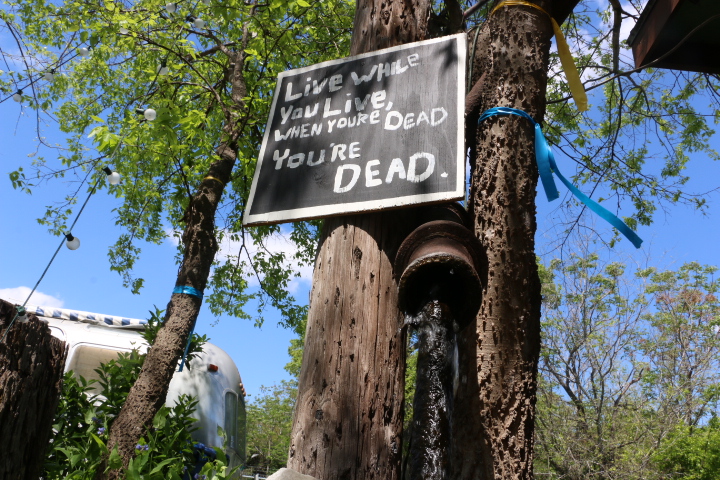By Erick DeLuna
Hot Wells was once a premier resort in San Antonio. Through its doors walked influential men and women such as Teddy Roosevelt, Charlie Chaplin, Porfirio Diaz and Sarah Bernhardt, that came to bathe and play in the spring’s sulfuric water.
In October 2015, Bexar County approved $4 million toward the preservation and improvement of the once lively resort. Plans include efforts to connect the site to the San Antonio River trails, renovation of the main building, stabilization of the ruins and the addition of lighting and facilities for visitors.
Throughout the years, fire, arson, vandalism, and erosion damaged the site, making it unrecognizable from its former glory. Only one building remains standing today alongside the graffiti tattered ruins of a once thriving bathhouse.
“It had suffered neglect and years of periodical fires,” said developer James Lifshutz. “I felt it was really important not just to conserve it, but figure out a way to bring it back into the public domain.”
In August 2012, Lifshutz, in collaboration with Bexar County, donated the site to preserve the rich history of the wells.
Lifshutz led and oversaw some of San Antonio’s most ambitious projects including the Blue Star Art Complex, The Cadillac Lofts, and Big Tex Apartments and now Hot Wells.

The resort lies between the San Antonio River and Mission San Jose, a UNESCO World Heritage site. But for almost half a century, it has struggled to remain iconic.
“Hot Wells has always held that place in people’s heart, and I was no exception,” Lifschutz said. ”There was a time, except for the Missions, that there was really nothing on the South Side that people really loved.”
Part of the stipulation between Bexar and Lifshutz was the establishment of a non-profit called Hot Wells Conservancy, which would oversee the future of the site and preserve its integrity.
The Conservancy
The history of Hot Wells is unique to San Antonio and has seen much history in its walls from a warm spring that brought in social elites to a film company that produced one of the first battles of the Alamo movies titled “The Immortal Alamo.”
Star Film Company, owned by French producer Gaston Melies, came to San Antonio in 1910 from Brooklyn. It was one of the first film companies in Texas and produced over 70 movies in San Antonio, but only three of the films survived.
“This is the county’s first-ever cultural historic park,” said Cindy Taylor, executive director of the Hot Wells Conservancy.
“It’s a huge monetary investment and the Conservancy will be in charge of taking care of that investment,” she said. “There’s nothing like it in the whole county.”
Taylor has big plans for the Hot Wells, including using the site as an outdoor classroom to teach children about history, agriculture and the importance of preservation.
“We want to build our programming around students by creating an interactive teaching experience for growth in the community,” Taylor said.
The remaining main building will be used as a boardroom, student center and will include a cooking space to show visitors different recipe ideas using organic vegetables harvested at the site.
One of the major events hosted by the Conservancy is the Harvest Feast, a fundraising event that collects donations for the improvement for Hot Wells.
After all, “The Conservancy raises private sector money to maintain the park after its creation,” Taylor said.
Taylor could not be prouder of what she has accomplished, stating how this endeavor is a “dream come true.” She added that this undertaking would be her “legacy project,” a proud achievement of her impact to the community.
Guardian of Hot Wells
The historic site isn’t without its issues. Vandalism and trespassing remain a constant problem.

To remedy the issue, Hot Wells Conservancy, Justin Parr volunteered to take care of the site, a caretaker of sorts, and protect it from further damage. He’s also a tour guide sometimes.
While working on an art piece, Parr finds inspiration where he calls home. Parsley, his scruffy, easy-mannered “guard dog” is his sole companion and follows him around as he explains the importance of protecting the site.
Parr offered a tour of the ruins and one can begin to tell that Hot Wells means a lot to him.
“I caught a couple of teenagers pushing down walls and knocking over archways the other day,” he said. “Not cool.”
This fondness for the site draws locals to come out and explore what little remains of decaying architecture.
“If I leave the gate open I will get at least one person a day, sometimes even up to five,” Parr said.
Parr is a local artist and former photo editor for The Paisano, the independent student newspaper for the University of Texas at San Antonio community. When he is not busy kicking teenagers off the site, he owns and manages Flight Gallery, an art space at Blue Star.
His art surrounds the robust walls that remain standing which adds a contemporary element to the decades-old structures.
The Well and the Water
Before 2014, a penetrating smell of eggs permeated the vicinity of Hot Wells, due to the warm, sulfuric water it produced. This water—said to cure even the worst of ailments—brought settlers from across the nation.
Artifacts at well sites around Texas show that Native Americans believed the water to be sacred and instead of shunning it, would drink it and form settlements around it.
“I had a chance to bathe in it,” Parr said, laughing. “It smells like eggs.”
The well, hidden between two palm trees and thick foliage, is almost close to being forgotten, as the waters that made it famous flow no more.
In January 2014, the well was officially capped.
Texas law stipulates that wells must lease or pay for usage. A new well will cost roughly $30,000 to drill, according to The Edwards Aquifer Website. Currently, there are no concrete plans to reopen the well, but locals remain hopeful about an opportunity to bathe in the water once more.
When asked if the well will re-open, Lifschutz remains optimistic. “That’s my hope and intent, to drill a new well,” he said.
Parr stands between the two palm trees, overlooking the ruins and reminisces, “for now, it’s just rumors, hopes and dreams.”






